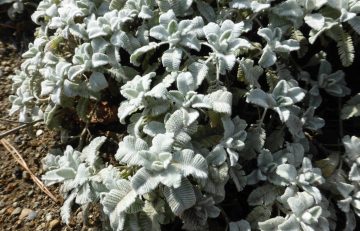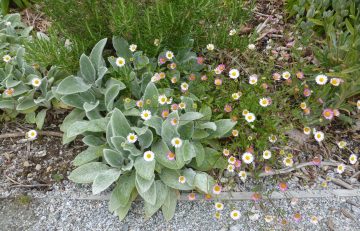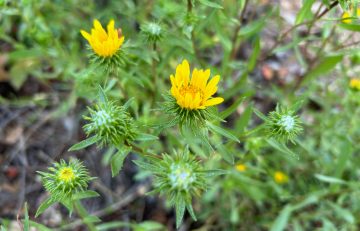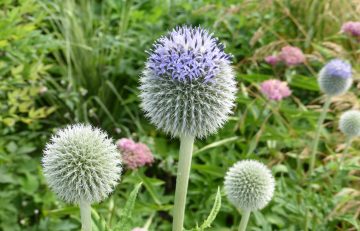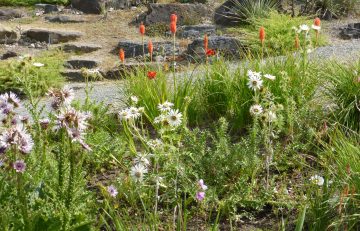
Echinops ritro
For summer blooms, few plants are as diverse, yet instantly recognizable as members of the sunflower or daisy family, Asteraceae. With some 300 different types in the Botanical Garden, the family represents the greatest diversity of any group in our collections. There are annuals, perennials, biennials, shrubs and subshrubs, and they hail from every region of the world. This monthly dispatch could become the longest on record if I were to mention even a fraction of those that flower in the summer, so I’ll try to contain myself.
The sunflower itself, Helianthus annuus, is both an important crop plant and a common summer ornamental. This year, because of the sudden decline of the Koelreuteria paniculata (golden rain tree) and its removal at the front entrance last year, horticulturist Scott Ferguson elected to fill the space with large-growing annuals, including a raft of sunflowers. Though probably not ripening their seeds until later in September, these sunflowers should be expanding their impressive sun-following flower heads in August. Note that most plants in this family share the same morphology (form, shape, structure). The flowers are always gathered together into compact, usually flattened heads with the appearance of single flowers. Individual flowers are tiny and generally of two types, which is why plants in the family are traditionally called composites; i.e., composed of more than one flower type. So-called “ray flowers” are most often arranged around the perimeter of the head and have an expanded strap-like petal that radiates outward (like the rays of the sun), while flowers in the centre of the head have petals that are symmetrical but tiny. These central blooms are known as disc flowers because their numbers make up the flattened disc of the flower head. There are exceptions to this basic arrangement in the family, but the disc-and-ray pattern is common, especially among the ornamentals.
Close to the boardwalk (behind the welcome sign) is a planting of an exuberant sneezeweed, Helenium ‘Moerheim Beauty’. Despite the common name, Helenium pollen is transported by bees, and too heavy to be wind-blown. The name sneezeweed apparently arose because ragweed pollen, which is highly allergenic, is dispersed at the same time. Although the David C. Lam Asian Garden holds relatively few composites compared with other sites in the Botanical Garden that have more sunshine, there are several of note here. For example, this year was one of the best ever for the July-flowering Inula magnifica (showy elecampane), and in the Physic Garden, Inula helenium (elecampane). We can expect the same from the early-August-flowering, low, fuzzy-leaved, Inula hookeri (Himalayan elecampane) (Farrer Trail and Lower Asian Way), and a tall selection of another Asian Inula species, the monumental Inula racemosa ‘Sonnenspeer‘(giant elecampane) (Upper Asian Way and Decaisne Trail, near the Asian Garden entrance). A close look at the any of these beautiful golden flowerheads reveals their classic composite construction.
Two composites dominate the Garry Oak Meadow Garden at this time of year: the near-ubiquitous Achillea millefolium (yarrow) and Grindelia hirsutula (hairy gumweed). The yarrow’s white flower heads are composed of tiny ray and disc flowers that have a musty smell, but they are important for beneficial insects. Gumweeds, too, attract a wide variety of insect pollinators. They are exceptionally drought tolerant, with sticky, bright yellow, rayed flower heads. Note also the curved, rubbery green bracts (a bract is a leaf-like organ associated with a flower stem) situated at the base of the flower head. Composites all have them: a set of bracts that protects the individual developing flower heads, then serves as a receptacle for the maturing seeds. The number of bracts and their various morphologies is often diagnostic for distinguishing between groups within the family.
While there are few composites on display in the Pacific Slope Garden, there is one in particular—western coneflower, Rudbeckia occidentalis—that deserves a second look. Rudbeckias are known for their often-substantial, brown, cone-like flower heads. Disc flowers are situated on the cone, and most species also have ray flowers around the base, but western coneflower has no rays. What it does have is a set of green, petal-like bracts at the base, where you’d expect the rays to be. A ring of yellow pollen-bearing anthers indicates the open flowers. The individual flowers are tiny, but popular with bees and butterflies.
The Food Garden hosts a wide variety of plants in the sunflower family (not least, sunflowers), but perhaps less obviously, lettuce (Lactuca sativa) and endive (Chicorium endivia), which are harvested prior to flowering—so, not particularly obvious members of the family. Calendula officinalis (pot marigold), a common Food Garden plant, definitely is recognizable as a sunflower relative. The bright orange ray petals are edible and the flowers attractive to beneficial insects. The wild-type of the species has daisy-shaped flowers, but most cultivated calendulas have “double flowers” with extra ray flowers produced where there are normally only disc flowers. So much the better for salad making. From the Food Garden, it’s only a few steps to the south-facing deck of the Garden Pavilion where a spectacular pale-purple display of Eurybia x herveyi (Hervey’s aster) awaits. Head over to the Carolinian Forest and the south-facing side of Lawson Grove to see an ever-expanding patch of Symphyotrichum novae-angliae (Michaelmas daisy). Michaelmas, a Christian festival, is celebrated on September 29th, but our plants clearly don’t follow the liturgical calendar; they start to flower in late August. Both Eurybia and Symphyotrichum were originally classified in the genus Aster.
Renaming in composites is an all-too-common occurrence. The summer-flowering Pentanema ensifolium (sword-leaved elecampane), for example, was originally named Inula ensifolia. It looks as much, with its large, sunny flowers displaying numerous, slender rays, but the plants are more diminutive. Look for it in the bed to the west of the Roseline Sturdy Amphitheatre facing Deborah Butterfield’s Columbia (the horse), and along the path toward the Sanctuary Garden. Also on this path are plantings of cotton-lavender, Santolina pinnata subsp. neapolitana, an evergreen subshrub from Italy. Like all our cultivated santolinas, these form billowy mounds and are smothered in musty-smelling, button-like flower heads in summer. Ours is an English selection, ‘Edward Bowles’, which has attractively dissected leaves and pale sulfur-yellow, ray-less flowers. There is another planting of this cultivar behind the bulb frame in the E. H. Lohbrunner Alpine Garden, and a vibrant-green-leaved, yellow-flowered, Santolina rosmarinifolia subsp. rosmarinifolia (green cotton lavender or holy flax) in the European section, and which is visible from the ‘Edward Bowles’ planting above the Amphitheatre.
Across the Service Road from the Asian Section of the Alpine Garden (part of the Contemporary Garden’s plantings) are several substantial groupings of the globe thistle, Echinops ritro ‘ Platinum Blue‘. Particularly attractive to bumblebees, its ray-less flowers are imbedded in chaffy, ice-blue spherical heads. The smaller-growing, but more formidably-spiny, thistle-leaved daisy, Berkheya cirsiifolia, will be in bloom well into August. Likewise, the yellow daisies of the false gerbera, Haplocarpha scaposa. Both are in the African Section of the Alpine Garden.
There are some 136 different composites in the Alpine Garden, a collection dwarfing the numbers in other parts of the Garden. Here is a (very restrained) sampling: Look in the North American section for the pink-turning-white daisies of the delightfully airy Mexican fleabane, Erigeron karvinskianus, the delicate New Zealand mountain daisy, Celmisia gracilenta in the Australasian section, and the furry, dissected foliage of the prostrate silver tansy, Tanacetum haradjanii, in Asia Minor and the Trough Courtyard. The tansy deserves close inspection, whether or not it has its flattened, yellow-button-flowerheads. I suspect that visitors will be able to check off many more composites that I haven’t mentioned on this or any route through the Garden, as well as see hundreds of other summer bloomers along the way.
- Tanacetum haradjanii
- Stachys byzantina ‘Silver Carpet’ with Erigeron karvinskianus
- Santolina rosmarinifolia
- Santolina pinnatasubsp. neopolitana ‘Edward Bowles’
- Rudbeckia occidentalis
- Pentanema ensifolium
- Inula hookeri
- Inula hookeri
- Helianthus annuus
- Helenium autumnale ‘Moerheim Beauty’
- Haplocarpha scaposa
- Grindelia integrifolia
- Eurybia x herveyi
- Erigeron karvinskianus
- Echinops ritro
- Celmisia gracilenta
- Calendula officinalis
- Berkheya purpurea and cirsiifolia
- Achillea millefolium
- Achillea millefolium
- Symphyotrichum novae angliae
Submitted by: Douglas Justice, Associate Director, Horticulture and Collections

